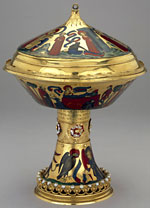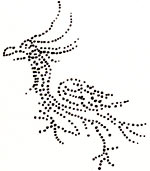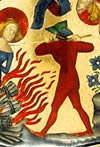items » cups
Cups
In his will Richard II expressed a wish to leave a gold cup to every Christian king. This clause becomes less surprising when we look at the inventory. Seven whole membranes, in all 157 entries, are devoted to gold hanaps, that is gold cups of various different shapes and sizes. The actual number of cups is swollen by a few sets, two of twelve matching pieces and a third of six. Most of these cups were made entirely of gold, although some were of beryl or rock crystal or another semi-precious material mounted in gold. A few were termed goblets or beakers. Some were paired with matching ewers for pouring wine or other liquids. Some cups were probably inherited by Richard, but many were gifts to the king and queen and the names of many of their French and English donors are recorded. Elsewhere in the inventory are silver-gilt cups, some very elaborate, mazersmazer - drinking vessel made of maple or other wood often with a metal rim , and the more routine sets of silver-gilt and silver cups in use in the wider household.
Cups as New Year's gifts
Some of the gold cups, were inscribed 'Happy New Year'. These were probably presented at New Year (1 January). This festival, rather than Christmas, was by a longstanding tradition going back to Roman times the day in the Middle Ages when gifts (strena in Latin, étrennes in French) were exchanged. In England the tradition persisted to the Victorian period and in some countries still exists today. The donors no doubt hoped that the cups would be in use on the king's high table at the feasts celebrated on that day. Other cups combined French and English badges, the white hart of Richard II with the broomcodsbroom - ('genêt') one of the heraldic badges of Charles VI of France in the form of branches, seed pods (broomcods), or broom flowers. Adopted by Richard II in 1396. of Charles VI, as on the Wilton Diptych; these are unlikely to date from before 1396, the meeting at Ardres and Richard's second marriage to Isabelle of France.
Richard II's cups

Royal Gold Cup given by Jean de Berry to Charles VI, 1391 (London, British Museum)
Larger image (51KB)
None of Richard's cups has survived, but it is possible to imagine in general terms what they would have looked like. Many were covered. Some had a jewelled pommel on the top and some a cresting around both cover and cup. Many stood on a foot and many were decorated in pointillépointillé - pattern formed of dots incised with a fine point . The translucent red enamel, known both in the fourteenth century and today as rouge cler, is recorded on a few cups as well as white enamel for lilies, roses, harts and rabbits, and white and green enamel for broomcods.
The Royal Gold Cup
Some of these features can be paralleled in the exquisite Royal Gold Cup in the British Museum. This cup is of approximately the right date. It is decorated with scenes from the life of St Agnes in basse taille enamel'basse taille' enamel - translucent enamel over a surface worked in relief to create light and shade . The Royal Gold Cup is covered and once had a cresting around both the cover and the cup as well as a jewelled pommel. Rouge clerenamel 'rouge cler' - translucent red enamel over gold which could only be successfully executed on gold is dominant in the palette. Birds and leaf trails are traced in fine dots on the gold ground.

Drawing of a detail from the Royal Gold Cup (London, British Museum), showing a bird in pointillé
The Royal Gold Cup was presented to Charles VI by his uncle, Jean de Berry, in 1391 and came to England in the fifteenth century, before being given by James I in 1604 to the Spanish ambassador to mark the signing of the peace with Spain. A painting in the National Portrait Gallery depicts the Spanish and English ambassadors meeting in Somerset House (see the National Portrait Gallery website). In the late nineteenth century, after being sold in Paris, it was bought for the British Museum.
Cups are listed on membranes 7–13 of the treasure roll.

